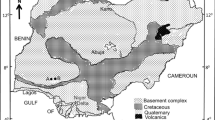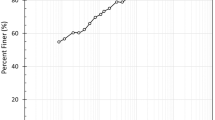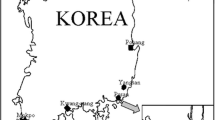Abstract
The effects of effective stress and void ratio on the secondary compressibility of the sandy and clayey soils were investigated in this study. The coefficient of secondary compression of Ottawa sand in single stage and stepwise loading tests increases with effective vertical stress while that of saturated kaolinite decreases with effective vertical stress. Multi-staged loading tests showed that at a given effective stress, the higher the void ratios of the soils, the higher the coefficients of secondary compression of the soils are. It was concluded that the secondary compressibility of a soil depends on not only the effective stress, but also the void ratio of the soil. A general relationship between the coefficient of secondary compression, and effective stress and void ratio was proposed for soil. The discrepancy of the dependency of secondary compressibility on effective stress for different soils was well explained using this relationship, moreover, the quasi-overconsolidated state of clayed soil induced by time effect and the effect of surcharge preloading on the secondary compressibility of soft ground were discussed in light of the general relationship.














Similar content being viewed by others
References
Mitchell JK, Soga K (2005) Fundamentals of soil behaviour, 3rd edn. John Wiley & Sons, New Jersey
Kargar SHR, Shahnazari H, Salehzadeh H (2014) Post-cyclic behavior of carbonate sand with anisotropic consolidation. Int J Civil Eng 12(4B):316–325
Lotfi E, Delfan S, Hamidi A, Shahir H, Asadollahfardi G (2014) A numerical approach for one dimensional thermal consolidation of clays. Int J Civil Eng 12(1B):80–87
Mojezi M, Jafari MK, Biglari M (2015) Effects of mean net stress and cyclic deviatoric stress on the cyclic behavior of normal consolidated unsaturated kaolin. Int J Civil Eng 13(1B):175–184
Walker LK, Raymond GP (1968) The prediction of consolidation rates in a cemented clay. Can Geotech J 5(4):192–216
Mesri G, Godlewski PM (1977) Time and stress compressibility interrelationship. J Geotech Eng 103(5):417–430
Mesri G, Castro A (1987) C α /C c concept and K 0 during secondary compression. J Geotech Eng 113(3):230–247
Ladd CC, Preston WB (1965) On the secondary compression of saturated clays. Research report R65-59, Research in Earth Physics, Phase Report No. 6, Depart. of Civil Engineering, MIT, Cambridge, Massachusetts
Tavenas F, Leroueil S, La Rochelle P, Roy M (1978) Creep behavior of an undisturbed lightly overconsolidated clay. Can Geotech J 15(3):402–423
Graham J, Crooks JH, Bell AL (1983) Time effects on the stress–strain behavior of natural soft clays. Geotechnique 33(3):327–340
Mesri G, Ajlouni MA (1996) Viscous behaviour of soil under oedometric conditions: discussion. Can Geotech J 34(1):159–161
Gao Y, Zhu H, Ye G, Xu C (2004) The investigation of the coefficient of secondary compression C α in odometer tests. Chin J Geotech Eng 26(4):459–463
Zhang W, Xie Y, Yang X (2007) Research on 1D secondary consolidation characteristics of compacted loess. Chin J Geotech Eng 29(5):765–768
Santagata M, Bobet A, Johnston CT, Hwang J (2008) One-dimensional compression behavior of a soil with high organic matter content. J Geotech Geoenviron Eng 134(1):1–13
Yin Z, Zhang H, Zhu J, Li G (2003) Secondary compression of soft soils. Chin J Geotech Eng 25(5):521–526
Venda Oliveira PJ, Correia A, Garcia M (2013) Effect of stress level and binder composition on secondary compression of an artificially stabilized soil. J Geotech Geoenviron Eng 139(5):810–820
Wang Z (2010) Soil creep behavior: laboratory testing and numerical modelling. PhD dissertation, Univ of Calgary, Calgary, AB
Murayama S, Michihiro K, Sakagami T (1984) Creep characteristics of sands. Soils Found 24(2):1–15
Mejia CA, Vaid YP (1988) Time dependent behaviour of sand. In: Proceedings of the international conference on rheology and soil mechanics, pp 312–326
Leong EC, Soemitro RAA, Rahardjo H (2000) Soil improvement by surcharge and vacuum preloadings. Geotechnique 50(5):601–605
Leung CF, Lee FH, Yet NS (1996) The role of particle breakage in pile creep in sand. Can Geotech J 33(6):888–898
Wang Z, Wong RCK (2010) Effect of grain crushing on 1D compression and 1D creep behavior of granular soil at high stresses. Geomech Eng 2(4):303–319
ASTM E112-13 (2013) Standard test methods for determining average grain size, ASTM International, West Conshohocken, PA
Yin JH, Graham J (1999) Elastic visco-plastic modelling of one-dimensional consolidation. Geotechnique 36(3):515–527
Kelln CG, Sharma J, Hughes D, Graham J (2008) An improved elastic-viscoplastic soil model. Can Geotech J 45(10):1356–1376
Casagrande A (1936) The determination of the pre-consolidation load and its practical significance. In: Proceedings of the 1st international soil mechanics and foundation engineering conference, vol 3. Cambridge, Massachusetts, pp 60–64
Butterfield R (1979) A natural compression law for soils (an advance on e-logp’). Geotechnique 29(4):469–480
Boone SJ (2010) A critical reappraisal of ‘Preconsolidation pressure’ interpretations using the oedometer test. Can Geotech J 47(3):281–296
Mesri G, Lo DOK, Feng T-W (1994) Settlement of embankment on soft clays. In: Yeung AT, Feaalio G (eds) Vertical and horizontal displacements of foundations and embankments. ASCE Geotechnical Special Publication, Reston, pp 8–56
Yu KP, Frizzi RP (1994) Preloading organic soils to limit future settlements. In: Yeung AT, Feaalio G (eds) Vertical and horizontal displacements of foundations and embankments. ASCE Geotechnical Special Publication, Reston, pp 8–56
Acknowledgments
The laboratory tests were performed in the Department of Civil Engineering of the University of Calgary. This study was also supported by Key Laboratory of Transportation Tunnel Engineering, Ministry of Education, Southwest Jiaotong University with Contract No. TTE2014-02.
Author information
Authors and Affiliations
Corresponding author
Rights and permissions
About this article
Cite this article
Wang, Z., Wong, R.C.K., Qiao, L. et al. Reconsidering Secondary Compressibility of Soil. Int J Civ Eng 15, 411–418 (2017). https://doi.org/10.1007/s40999-016-0054-x
Received:
Revised:
Accepted:
Published:
Issue Date:
DOI: https://doi.org/10.1007/s40999-016-0054-x




